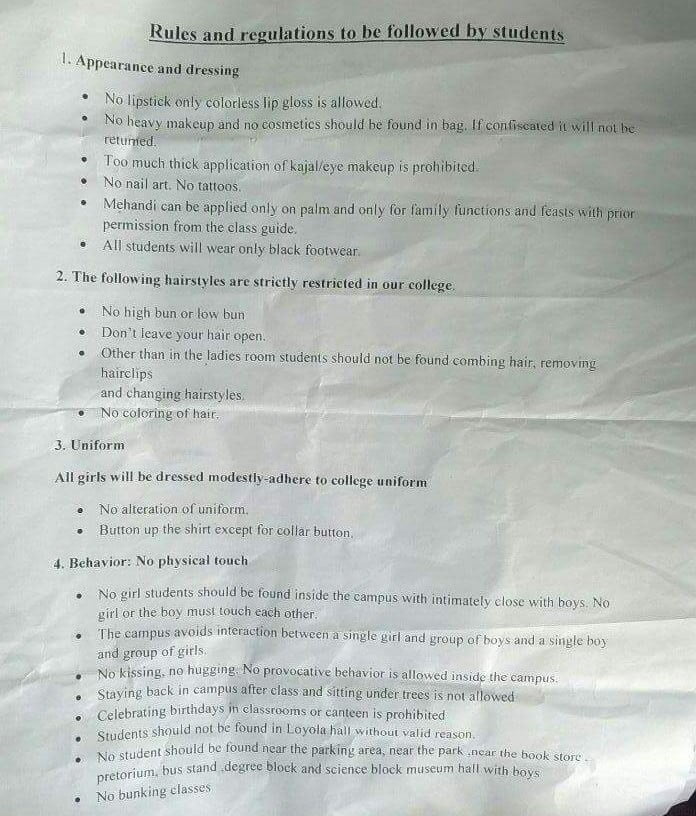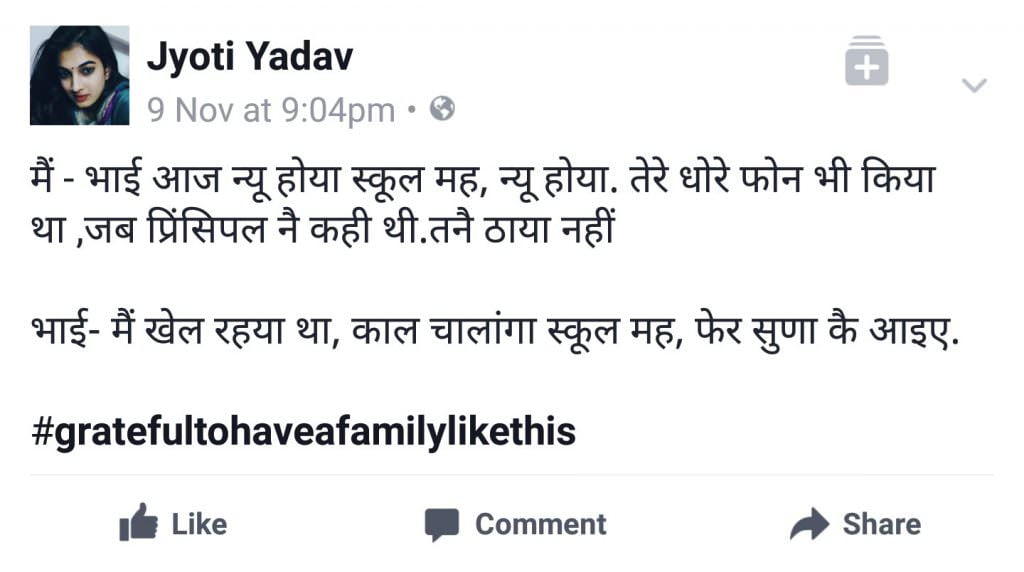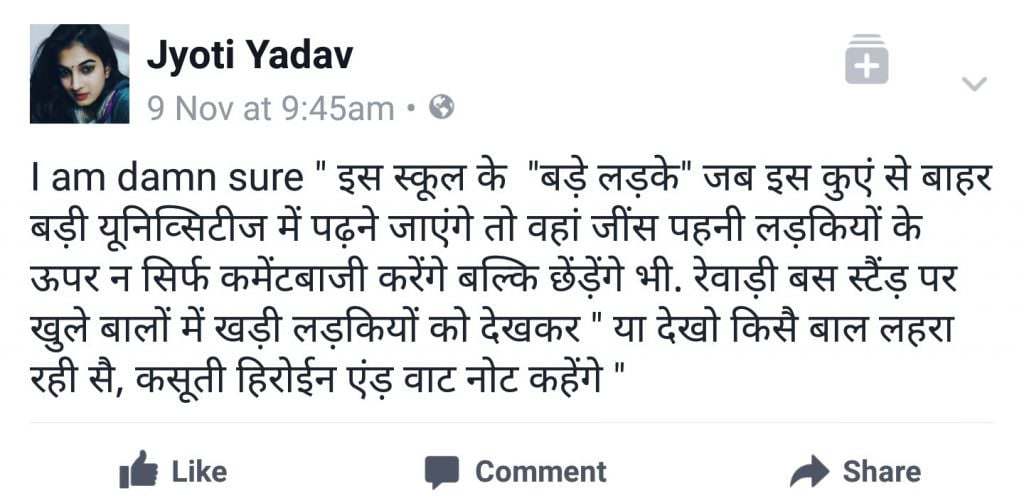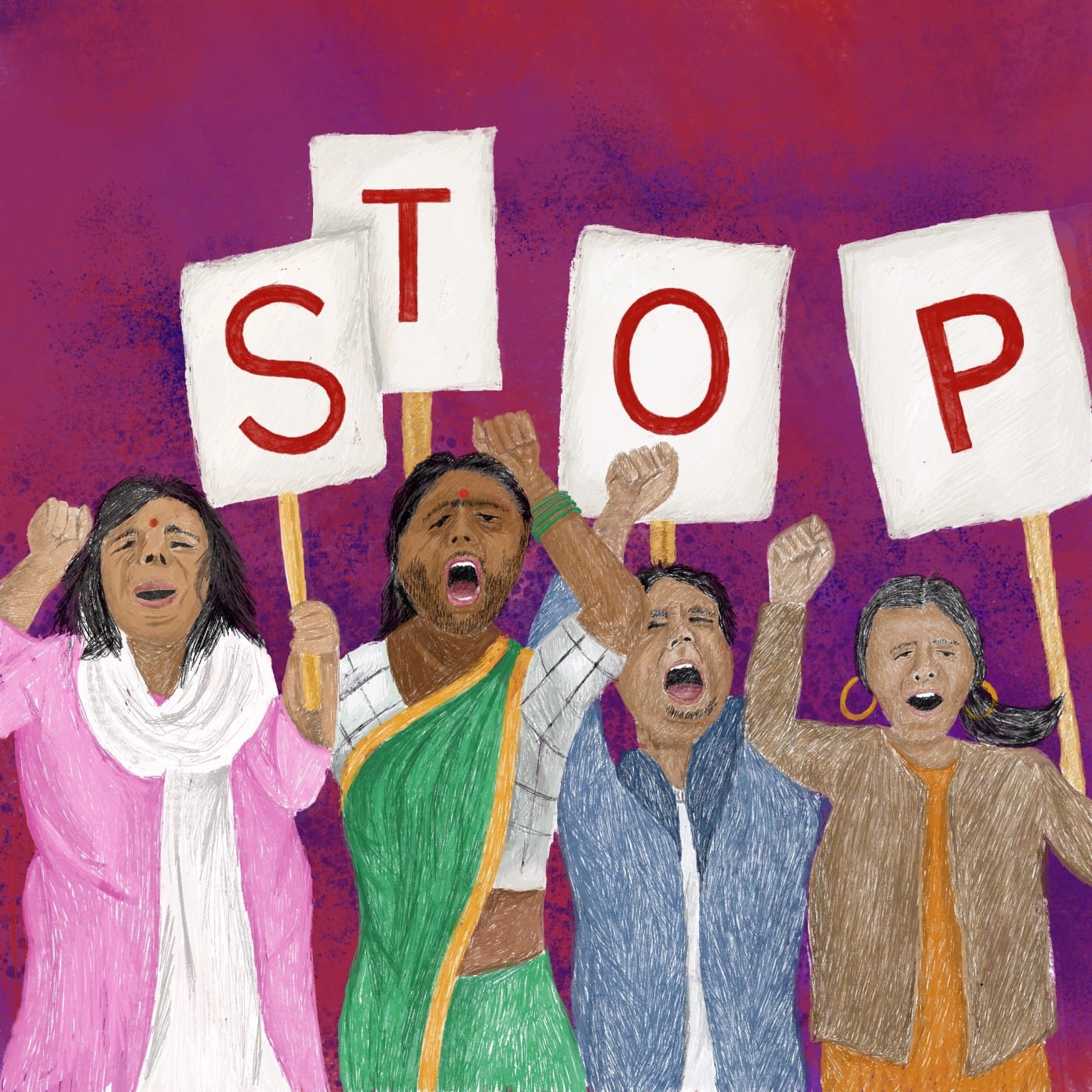Sexist rules for women in educational institutions have been known to exist since time immemorial, commonly understood as ‘campus sexism.’ They range from policing of women’s clothes and appearance to restrictions on mobility within the school, or college building. University and school administrations issue gender-discriminatory rules for women students and employees, and act as if they are doing a favour to women by letting them study, or work there because public education is not meant for them. Elaborate guidelines and instructions on what to wear, what not to wear, what hairstyle to make, how to carry oneself, how to behave, how much to socialize, etc. are more strictly laid down for women if it’s a co-education school or college.
In many schools and colleges, girls are ordered not to go out during lunch break and talk to boys. If a girl and a boy are seen together, both are given warnings, but the girl is reprimanded more than the boy. It is considered girl’s responsibility to keep her distance from the boys in the school, or university since boys cannot be expected to do so because “boys will be boys.”

Sexist rules in St. Aloynius College, Mangalore
Source: https://satshyatharien.wordpress.com
For boys and men, the rules are generally about not bunking classes, not celebrating birthdays in classroom, wearing clean and proper uniforms, with other similar requirements. Moreover, these rules are binding on male students only, and not on male teachers. On the other hand, the rules for girls and women go far beyond just cleanliness, or maintenance of discipline, and more often than not, they apply to women teachers too.
Also Read: Misplaced Priorities: How Educational Institutions Perpetuate Campus Sexism
Girls are asked to wear skirts below their knees, to keep their hair tightly plaited, to not make hair buns, to not apply kohl or even a coloured lip gloss, to wear loose fitted shirts, etc. Women teachers are also forbidden from wearing jeans, while there’s no such dress code for male teachers. In other words, the rules for women have very little to do with the school’s decorum and everything to do with exercising control over their sexuality and body.
One of the many examples of educational institutions that practice blatant sexism is Astha International Soch School, a school in Rewari, Haryana, India. Like numerous other schools in this country, this one also believes that the “honour” and safety of a woman lies in her own hands, or, more precisely, in her dress. All women who work there have to follow the school’s sexist dress code. Women teachers are not allowed to wear jeans, come to school without a chunni, or leave their hair unbound, particularly if they are teaching upper primary and senior secondary classes. But Jyoti Yadav refused to obey. She outrightly told the principal of the school that she would rather leave the job than tie her hair.
Jyoti Yadav, a woman in her early twenties, is from Mahendragarh district of Haryana state in northern India. She was working at Astha International Soch School, Rewari where she taught English subject to 6th, 7th and 8th classes.
She had started this job barely a week ago from the date of the incident. She told me that she was not informed about any special rules on dressing for female teachers in written or even orally when she joined. But soon, the sexist atmosphere of the school stood naked before her eyes as she came to know about certain rules for all female teachers to be followed. She was asked not to wear cut-sleeved suits, or jeans at work. Initially, she accepted all of this for the sake of her job, but with resentment. Later, she lost her cool when she was especially called by the Principal immediately after morning prayer to his office who then told her to plait her hair, and not come to school with open hair in the future.
The reason that he gave for his objection was that the growing (adolescent) boys coming to study in the school might get a “wrong impression or lesson” from her loose hair. He implied that women teachers are required to dress ‘modestly’ so that the senior boys in the school don’t get distracted and pass indecent comments on their teacher. These rules of dressing and hairstyle do not apply to women who teach the primary wing as little boys are naturally in no danger of being ‘misguided’ or ‘distracted’ by their teacher’s untied hair.
I asked her if there are any rules on dressing for the male teachers of the school as well. She answered that nobody cares what they are wearing or how they look; they are only expected to give good results and nothing else.
Yadav didn’t listen to the sexist rhetoric of the Principal. She unequivocally told him that she does not like to bind her hair, and she won’t bind them for him and his school. She also told him to stop spoiling his senior boys by making such sexist rules and giving the boys so much undue attention. She said, “change female teachers pe restrictions lagaane se nahi, apne bacchon ko sahi shiksha dene se ayega.”
The two had a heated debate on the subject but Jyoti refused to acquiesce and apologize. She straightaway told him that he could keep his job and she would keep her unbound hair (“aap apni naukri rakho, main apne khule baal”). The principal had never encountered such resistance from a female teacher before and was surely not expecting that reply from Jyoti, so you can imagine how dumbstruck he must have gone at that moment.
What is heartwarming is that all her family members supported her decision of leaving the job when she returned home and narrated the entire incident to them. Read below the reactions of her aunt and her brother when she told them.

Source: Facebook profile, Jyoti Yadav

Yadav says that she understands every workplace has its own dress code which every employee must follow; her problem is not with the rules but the kind of mentality where these rules are coming from. The reason behind her refusal to tie up her hair is well explained in the following status that she posted on Facebook minutes after leaving the Principal’s office.

When you are asking the women teachers or students in an educational institution to tie up their hair or not wear jeans for the sake of boys, you are sending out a very dangerous message to the young men and boys coming there to be ‘educated’. You are telling them that women who wear jeans and keep their hair loose can be teased, harassed, and molested. You are telling them that street sexual harassment and sexual assault are actually victim’s faults because they dared to step out of their house with their hair untied.
If this is not your intention in implementing these so called rules, why are you making women’s legs and hair such big issues in the minds of these young boys? Why should they be distracted just because their teacher comes to class with her hair open? Shouldn’t they be taught to think otherwise? Shouldn’t they be made accustomed to seeing girls wearing jeans or skirts right from early years so that it is not a matter of excitement or “provocation” for them when they grow up? Why must women be exclusively made to observe certain rules and restrictions while men have no such codes to worry about?
Educational institutions try their best to pretend that the rules on dressing and conduct solely exist to foster a respect for discipline among children and maintain the decorum of the institution. If pointed out that these rules are more severe and arbitrary in case of girls and women, or asked why they exclusively apply to women, they come up with the age-old narrative of “protection” as an excuse. It’s time that we challenge and dump these discriminatory rules in educational institutions as Jyoti did. The things that children learn at school leave a lasting impact on their minds. Schools must work towards making children more gender-sensitive, and not sexist. Jane Martinson stresses upon the same in her article for The Guardian, when she says, “Given that so much of this is experienced in schools, shouldn’t the first port of call be the classrooms where children are meant to learn about sex and relationships?”
Concluding with an image of Jyoti’s beautiful hair that she posted on Facebook after standing up against sexism at her workplace.

Why is it such a big deal, really?!





I feel that hairstyles don’t affect education. Hair policy should be removed because it is gendered and discriminatory. It also hurts LGBT students. This policy also violates human rights. Boys should be allowed to grow their hair so that their brains get protected from injury during accidents. Girls should be allowed to have long haircuts and untied. They can also have short haircuts, ponies, braids, and other simple and cute hairstyles. Hairbands and clips can be used. The reason is that hair loss has now become a common problem. Another reason is scalp infection. Third it is time saving and stress free. Hair is a protective organ as well as an identity. Concern about biology is more important than looks. Without individuality discipline makes no sense. All the schools of our country should change their mindsets immediately. Beware of human rights.